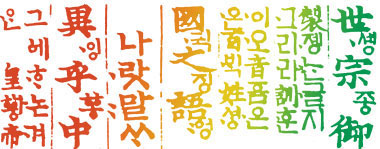한국 (KOREA)
LETS LEARN KOREA한국 (KOREA)
LETS LEARN KOREAkorean drama
Han River Ballad

Title: 한강수타령 / Han-kang-soo Ta-ryeong
Also known as: Ode to the Han River / The Ballad of Han River / A Song of Han River
Episodes: 51
Broadcast network: MBC
Broadcast period: 2004-10-02 to 2005-3-27
Synopsis
“Song of the Han River” is a story of life and love involving a vibrant middle-aged woman, her two daughters, a niece, a nephew, and a cast of other characters surrounding them. The woman, named Kim Young-hee (Go Doo Shim), is a widow who sells fish to support her family. Through their often turbulent lives, we are able to experience the difficulties of a not uncommon family and the persistence of the love its members have for one another.
MBC TV’s new weekend drama, “Song of the Han River,” revolves around the lives of a vibrant middle-aged woman, her two daughters and a cast of other characters surrounding them. Like your mother back home, who would take a switch to you if you were bad and give you a pat on the back when you were feeling down, “Song of the Han River” is a warm but enervating story of ordinary people dealing with the normal difficulties of life.
To bring about a sort of renaissance in MBC’s weekend drama offerings, “Song of the Han River” ambitiously reunites the team of Kim Jeong-su and Choi Jong-su from the popular MBC drama “You and I” for the first time in 6 years. Planning and preparations for this new presentation were undertaken from last May, and the target audience ranges from those in their early 30s to those in their 50s.
Producer Choi Jong-su revealed that his intention was to create a drama dealing with a variety of characters. “Song of the Han River” also portrays the linkage between the past and present by making use of the Han River as a central theme. Throughout its entire length, this new drama portrays a range of Korean emotions and sentiment, and particular care was taken in casting so as to attract young viewers in addition to the targeted middle-age group. The title comes from the eponymous theme song, “Song of the Han River,” originally a folk song that has been re-cut with an upbeat modern feel by the group The Bubble Sisters. Work is underway however, to connect the mood of the song’s original version with the drama’s overall feel, and it will be interesting to see just how this is accomplished.
Source: MBC Global Media
Cast
Go Doo Shim as Kim Young-hee
Kim Hye Soo as Yoon Ga-young
Kim Min Sun as Yoon Na-young
Lee Yoon Ji as Yoon Da-young
Choi Sung Joon as Yoon Soo-young
Bong Tae Kyu as Choi Kang-soo
Park Han Byul as Mee-ae
Kim Suk Hoon as Lee Joon-ha
Han In Soo as Lee Tae-keun
Park Jung Soo as Park Dan-ok
Ahn Se Mi as Lee Joon-mi
Choi Min Soo as Shin Ryul
Production Credits
Producer: Choi Jong Soo
Director: Choi Jong Soo
Asst. Directors: Kim Geun Heung, Lee Sang Hyup
Screenwriter: Kim Jung Soo
learn korea
 special thanks of my friend
special thanks of my friend
|
The Korean Alphabet |
Consonants |
ㄱ | g,k | ㅂ | b,p | ㅋ | k |
ㄴ | n | ㅅ | s | ㅌ | t |
ㄷ | d,t | ㅇ | ng,silent | ㅍ | p |
ㄹ | r,l | ㅈ | j | ㅎ | h |
ㅁ | m | ㅊ | ch |
|
|
Vowels |
ㅏ | a | ㅗ | o | ㅠ | yu |
ㅑ | ya | ㅛ | yo | ㅡ | eu |
ㅓ | eo | ㅜ | u | ㅣ | i |
ㅕ | yeo |
|
|
|
tourist attraction



|
|
| Dialogue 1. At Namsan Hanok Village | ||||||||||||||||||||||||||||
| ||||||||||||||||||||||||||||
| Dialogue 2. At Seoul Museum of History | ||||||||||||||||||||||||||||
|
